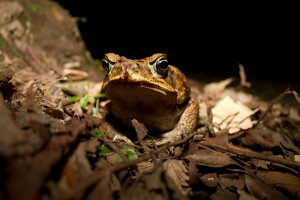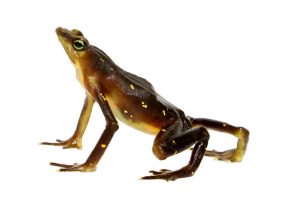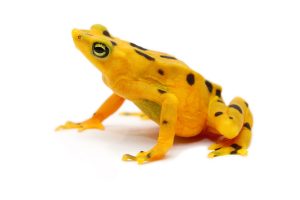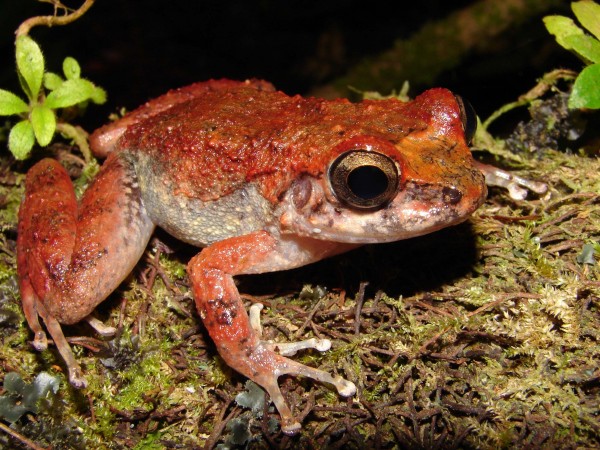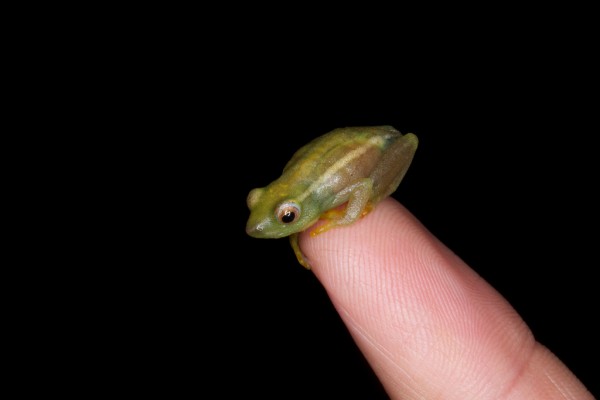Golden frogs are extinct in the wild, but in addition to two Panamanian facilities, about 50 zoos and aquariums in the USA participate in a Species Survival Program led by the Maryland Zoo to help breed and conserve these precious animals. Investigate TV interviews Matt Evans at the Smithsonian’s National Zoo and Conservation Biology Institute about his work with this species.
Category Archives: why frogs matter
Last refuge of harlequin toads
In August 2022 a diverse team of researchers, conservationists, artists, representatives of local and Indigenous communities and park rangers met at Estación Experimental San Lorenzo in the Sierra Nevada de Santa Marta in Colombia with one common objective in mind: studying and preserving Harlequin Toads (genus Atelopus). The meeting was part of the project “The last refuge of Harlequin Toads: working together to save the jewels of the forest”, funded by the National Geographic Society.
The project involves a large group of people and organizations, including several Amphibian Survival Alliance (ASA) partners, ASA Future Leaders of Amphibian Conservation and members of the Atelopus Survival Initiative (ASI). The partnership between scientists, conservationists, artists, and educators resulted in the creation of scientific protocols for research and monitoring of Atelopus and the publication of a children’s book and songs about Harlequin Toads. The continued persistence of the frogs was no mystery to local members of the Arhuaco community who said the reason they disappeared everywhere else is because in other places the harmony between the earth and its people had been disrupted, but here was special because the people respect their environment and its inhabitants. As researchers discussed the possibilities that may allow the frogs to persist here in this unique place and how unlocking the mysteries may help recover harlequin frogs elsewhere.
The team was led by Lina Valencia, coordinator of the IUCN SSC Amphibian Specialist Group Atelopus Task Force, and Luis F. Marin da Fonte, coordinator of the ASI and Director of Partnerships & Communications at the Amphibian Survival Alliance. Other team members were Jeferson Villalba, José Luis Peres, and Sintana Rojas (ASA partner Fundación Atelopus), Brian Gratwicke (ASA partner Smithsonian Conservation Biology Institute), Pedro Peloso (ASA Future Leader of Amphibian Conservation), Juan Manuel Guayasamin (Jambato Alliance), Janni Benavides, Julia Alvarez and Andrés Alvarez (Jacana Jacana), Delia Basanta (University of Nevada), Mirna Garcia-Castillo (Universidad Nacional Autónoma de México), Ruperto Chaparro and Rufino Arroyo (Arhuaco Indigenous community), Sara Ramírez (Selva Selvita), Timothé Le Pape (Cerato, Association Herpétologique de Guyane), and Lilia Mejia, Anibal Benitez, Jorge Meza, Elmer Ortega and Angela Arias (Parques Nacionales Naturales de Colombia). Additional team members that were not able to join the fieldwork activities include Luke Linhoff (Smithsonian Conservation Biology Institute) and Jamie Voyles (University of Nevada).
Panamanian toads may harbor a cure for Chagas disease
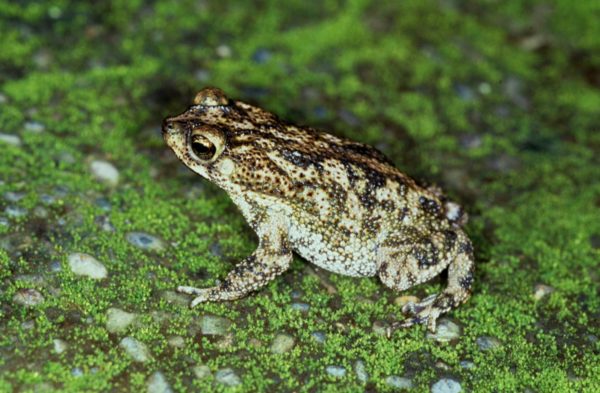 Panamanian toads Rhinella centralis are distinguished by their dorsal skin covered with pointed warts. They are common along the Pacific coastal areas, often in urban areas around Panama City and small towns, and form large choruses on rainy nights. The small but strongly swollen poison glands on their heads secrete a white toxic goop. This effective defense mechanism makes predators spit them out, or froth at the mouth, vomit and it may even kill them if they try to eat the toad.
Panamanian toads Rhinella centralis are distinguished by their dorsal skin covered with pointed warts. They are common along the Pacific coastal areas, often in urban areas around Panama City and small towns, and form large choruses on rainy nights. The small but strongly swollen poison glands on their heads secrete a white toxic goop. This effective defense mechanism makes predators spit them out, or froth at the mouth, vomit and it may even kill them if they try to eat the toad.
Scientists working at INDICASAT, the University of Panama and STRI began screening wild frogs for substances with pharmacological potential to treat various tropical diseases. When they analyzed secretions from these toads they discovered a chemical in the poison glands called 19-hydroxy-bufalin. They found that this chemical was very potent at killing the parasites that cause Chagas disease, and that it was not very toxic to cells. Chagas disease is a neglected tropical disease that kills 10,000 people per year, and current medications used to treat the disease are not very effective, particularly in acute cases. The fact that this chemical is quite selective with low cell toxicity means it is a promising compound that make it a candidate compound to further explore as a potential way to treat Chagas disease.
Read the research here:
Earth optimism: Frogs
What’s Working in Conservation
The global conservation movement has reached a turning point. We have documented the fast pace of habitat loss, the growing number of endangered and extinct species, and the increasing speed of global climate change. Yet while the seriousness of these threats cannot be denied, there are a growing number of examples of improvements in the health of species and ecosystems, along with benefits to human well-being, thanks to our conservation actions. Earth Optimism is a global initiative that celebrates a change in focus from problem to solution, from a sense of loss to one of hope, in the dialogue about conservation and sustainability.
Dr Brian Gratwicke will present the Panama Amphibian Rescue and Conservation Project on Saturday April 22 5:15pm on the panel Science on the Edge
More Good Reasons Not to Lick a Toad
A New Review of Chemicals Produced by the Toad Family, Bufonidae
As human diseases become alarmingly antibiotic resistant, identification of new pharmaceuticals is critical. The cane toad and other members of the Bufonidae family produce substances widely used in traditional folk medicine, but endangered family members, like Panama’s golden frog, Atelopus zeteki, may disappear before revealing their secrets. Smithsonian scientists and colleagues catalog the known chemicals produced by this amphibian family in the Journal of Ethnopharmacology highlighting this largely-unexplored potential for discovery.
“We’re slowly learning to breed members of this amphibian family decimated by the chytrid fungal disease,” said Roberto Ibañez, Panamanian staff scientist at the Smithsonian Tropical Research Institute (STRI) and in-country director of the Panama Amphibian Conservation and Rescue (PARC) project. “That’s buying us time to understand what kind of chemicals they produce, but it’s likely that animals in their natural habitats produce an even wider range of compounds.”
15 of 47 frog and toad species used in traditional medicine belong to the family Bufonidae. For millennia, secretions from their skin and from glands near their ears called parotid glands, as well as from their bones and muscle tissues have been used as remedies for infections, bites, cancer, heart disorders, hemorrhages, allergies, inflammation, pain and even AIDS.
Toxins of two common Asian toad species, Bufo gargarizans and Duttaphrynus melanostictus, produce the anticancer remedies known as Chan Su and Senso in China and Japan, respectively. Another preparation used to treat cancer and hepatitis, Huachansu or Cinobufacini, is regulated by the Chinese State Food and Drug Administration. In Brazil, the inner organs of the toad, Rhinella schneideri, are applied to horses to treat the parasite Habronema muscae. In Spain, extract from the toad Bufo bufo is used to treat hoof rot in livestock. In China, North and South Korea, ranchers use the meat of Bufo gargarizans to treat rinderpest.
Only a small proportion of the more than 580 species in the Bufonidae family have been screened by scientists. “In Panama, not only do we have access to an amazing diversity of amphibian species,” said Marcelino Gutiérrez, investigator at the Center for Biodiversity and Drug Discovery at Panama’s state research institute, Instituto de Investigaciones Cientificas y Servicios de Alta Tecnologia (INDICASAT), “we’re developing new mass spectrometry and nuclear magnetic resonance spectroscopy techniques to make it easier and cheaper to elucidate the chemical structures of the alkaloids, steroids, peptides and proteins produced by these animals. We work closely with herpetologists so as not to further threaten populations of these species in the wild.” Their efforts to catalog chemicals produced by the Bufonidae included researchers from the University of Panama, Vanderbilt University, in Tennessee, U.S.A. and Acharya Nagarjuna University in Guntur, India.
Most of the chemicals produced by frogs and toads protect them against predators. Atelopus varius contains tetrodototoxin. Chiriquitoxin is found in Atelopus limosus, one of the first species that researches succeeded in breeding in captivity as well as in Atelopus glyphus and Atelopus chiriquiensis. An atelopidtoxin (zetekitoxin) from the Panamanian golden frog, Atelopus zeteki, appears to consist of two toxins. Toxins from a single frog skin can kill 130-1000 mice.
The golden frog, A. zeteki, Panama’s national frog, is the only species of the genus Atelopus that secretes zetekitoxins. Threatened by the chytrid fungal disease that infects the skin and causes heart attacks, with collection for the exotic pet trade and by habitat destruction, if golden frogs were to disappear, they would take this potentially valuable chemical with them.
More than 30 percent of amphibians in the world are in decline. Racing to stay ahead of the wave of disease spreading across Central America, Panama is leading the way in conservation efforts. The Smithsonian’s Panama Amphibian Rescue and Conservation project (PARC) identified several Atelopus species in danger of extinction, and are learning how to create the conditions needed to breed them in captivity. Not only do animal caretakers at their facilities in Gamboa and El Valle, Panama experiment to discover what the frogs eat, they also recreate the proper environment the entire frog life-cycle: egg laying, egg hatching and tadpole survival, to successfully breed Atelopus. Each species has unique requirements, making it an expensive challenge to create this Noah’s ark for amphibians.
The chemical building blocks amphibians use to create toxic compounds come from sources including their diet, skin glands or symbiotic microorganisms. Toads in the genus Melanophryniscus sequester lipophilic alkaloids from their complex diet consisting of mites and ants. Researchers found that toxins found in a wild-caught species of Atelopus could not be isolated from frogs raised in captivity: another reason to conserve frog habitat and to begin to explore the possibility of releasing frogs bred in captivity back into the wild.
Learn more about amphibians by visiting the PARC blog and the Panama’s Fabulous Frogs exhibit at the Smithsonian’s Culebra Point Nature Center in Panama.
The Smithsonian Tropical Research Institute, headquartered in Panama City, Panama, is a part of the Smithsonian Institution. The Institute furthers the understanding of tropical nature and its importance to human welfare, trains students to conduct research in the tropics and promotes conservation by increasing public awareness of the beauty and importance of tropical ecosystems. Website. Promo video.
# # #
Rodriguez, Candelario, Rollins-Smith, Louise, Ibanez, Roberto, Durant-Archibold, Armando, Gutiérrez, Marcelino. 2016. Toxins and pharmacologically active compounds from species of the family Bufonidae (Amphibia, Anura). Journal of Ethnopharmacology, doi:10.1016/j.jep.2016.12.021
Join us as together we Fight for Frogs
 Frogs matter. As a kid in nursery school, I remember observing tadpoles metamorphose into froglets right before our eyes in the classroom. It was like watching a magic trick over and over again. As I grew more interested in these cool little creatures, I learned that some frogs reproduce using pouches, others by swallowing their own eggs and regurgitating their young, others still by laying eggs that hatch directly into little froglets. It was like discovering not one magic trick, but an entire magical world—except this world was no illusion, it was real. My formative experiences both in the classroom and out rummaging around cold rainy ponds at night with my best friend and a headlamp spurred me into a career in the biological sciences. They also instilled in me a deep appreciation for the incredible diversity of life.
Frogs matter. As a kid in nursery school, I remember observing tadpoles metamorphose into froglets right before our eyes in the classroom. It was like watching a magic trick over and over again. As I grew more interested in these cool little creatures, I learned that some frogs reproduce using pouches, others by swallowing their own eggs and regurgitating their young, others still by laying eggs that hatch directly into little froglets. It was like discovering not one magic trick, but an entire magical world—except this world was no illusion, it was real. My formative experiences both in the classroom and out rummaging around cold rainy ponds at night with my best friend and a headlamp spurred me into a career in the biological sciences. They also instilled in me a deep appreciation for the incredible diversity of life.
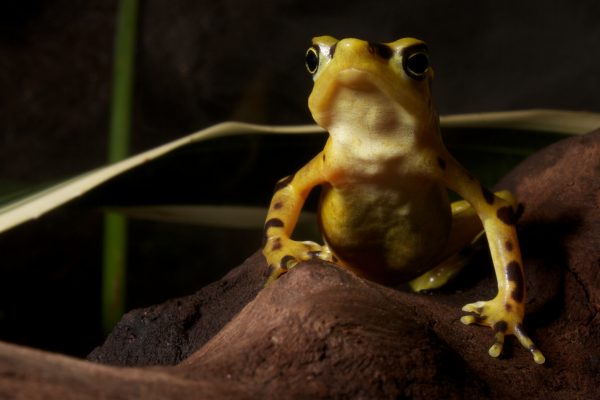 Today I am focused on conserving that incredible diversity specifically among amphibians in Panama, which is home to an astounding 214 amphibian species. Or at least it was. When a deadly amphibian chytrid fungus swept through, nine species disappeared entirely, including the country’s national animal, the beautiful Panamanian golden frog.
Today I am focused on conserving that incredible diversity specifically among amphibians in Panama, which is home to an astounding 214 amphibian species. Or at least it was. When a deadly amphibian chytrid fungus swept through, nine species disappeared entirely, including the country’s national animal, the beautiful Panamanian golden frog.
 Since 2009, the Panama Amphibian Rescue and Conservation Project has spearheaded efforts to bring at-risk species into rescue pods to ride out the storm while we work on finding a cure. We’ve worked with partners to conduct several experiments in search of a cure and to better understand why some frogs resist infection and others do not. We have built new facilities that house highly endangered species of amphibians as part of a bigger global push to create an “Amphibian Ark.” These efforts and those of our colleagues around the world give me profound hope for our amphibian friends.
Since 2009, the Panama Amphibian Rescue and Conservation Project has spearheaded efforts to bring at-risk species into rescue pods to ride out the storm while we work on finding a cure. We’ve worked with partners to conduct several experiments in search of a cure and to better understand why some frogs resist infection and others do not. We have built new facilities that house highly endangered species of amphibians as part of a bigger global push to create an “Amphibian Ark.” These efforts and those of our colleagues around the world give me profound hope for our amphibian friends.
But we need your help.
Although frogs are the orchestral backdrop to every pond and forest, frogs have no voice to represent themselves, and they certainly can’t write checks. It’s up to professional conservationists, including the rescue project’s 12 talented conservationists in Panama, to save frogs so that others can enjoy them. This, however, requires money. From now until the end of August, our generous sponsor Golden Frog—a global online services provider with a terrific name—will match donations to the rescue project up to $20,000, helping us raise money critical to our fight for frogs. Your donations during the Fight for Frogs campaign will buy us equipment to care for the frogs in the rescue pods, help us continue to conduct experiments to find a cure, ensure crucial breakthroughs, and ultimately one day see the return of these incredible species to their home in the wild.
Together, let’s make a stand. Together, let’s #FightForFrogs.
The Panama Amphibian Rescue and Conservation Project is a project partnership between the Cheyenne Mountain Zoo, the Houston Zoo, Zoo New England and Smithsonian Institution. You can follow the Fight for Frogs campaign on Twitter using the #FightForFrogs hashtag or on the rescue project’s Facebook page.
Hanging around.
Cute Frog of the Week: March 25, 2013
The Ecuador cochran frog is a brightly colored frog found most often on vegetation next to streams in montane forests. Although its name points to Ecuador, it appears to have disappeared from its original region and is now found most commonly in Columbia. The Cochran frog population is currently in a decline due to habitat loss from deforestation for agricultural development, logging and human settlement. The introduction of alien predatory fish to the area and pollution resulting from the spraying of illegal crops has also had a negative effect on the species. Due to these factors, the IUCN has listed them as vulnerable on the IUCN Red List.
Photo by Lucas M. Bustamante via Arkive.
Every week the Panama Amphibian Rescue and Conservation Project posts a new photo of a cute frog from anywhere in the world with an interesting, fun and unique story to tell. Be sure to check back every Monday for the latest addition.
Send us your own cute frogs by uploading your photos here: http://www.flickr.com/groups/cutefrogoftheweek/
Stealing your heart.
Cute Frog of the Week: March 4, 2013
The turquino robber frog is a small frog, but large for Eleutherodactylids. It is a semi-aquatic frog found in small mountain streams in cloud forest and fragmented areas at high altitudes. Endemic to Cuba, this frog is known only from the Sierra del Turquino (Sierra Maestra Mountains) in eastern Cuba. These little robbers can be found on stream banks clinging to wet rocks in the splash zone, prepared to dive underwater for a quick getaway if needed. Due to habitat loss and their limited area of occupancy, this species is classified as critically endangered by the IUCN.
Photo by Ariel Rodriguez via Arkive.
Every week the Panama Amphibian Rescue and Conservation Project posts a new photo of a cute frog from anywhere in the world with an interesting, fun and unique story to tell. Be sure to check back every Monday for the latest addition.
Send us your own cute frogs by uploading your photos here: http://www.flickr.com/groups/cutefrogoftheweek/
Hops and spots.
Cute Frog of the Week: February 25, 2013
This little polka-dotted guy is actually one of the most distinctive poisonous frogs. Adults are black or brown, sporting fashionable white “polka-dots” that cover their entire body. This spotting is highly variable from frog to frog, with the exception of a single spot under the chin and an oval spot on the underside of the thighs. The species is known from a single location in the vicinity of Santa Rosa, Cajamarca, Peru and often lives in giant bromeliad flowers. Unfortunately, because of land destruction for coffee farms in the area around Santa Rosa, this species is losing its habitat and becoming severely threatened in the wild. Humans have also begun to want these beautiful amphibians as terrarium pets. These threats have caused the IUCN to classify the spotted frog as endangered by the IUCN.
Photo by Jean-Francois Brousseau via ARKive.
Every week the Panama Amphibian Rescue and Conservation Project posts a new photo of a cute frog from anywhere in the world with an interesting, fun and unique story to tell. Be sure to check back every Monday for the latest addition.
Send us your own cute frogs by uploading your photos here: http://www.flickr.com/groups/cutefrogoftheweek/
Frog Love on Valentine’s Day
This Valentine’s Day we asked some of the rescue project’s researchers why they love frogs. Here’s what we got back from a few biologists at the Smithsonian’s National Zoo. The common link? A life-long love of wildlife.
“My favorite childhood memories revolve around my mother taking me down to the nearest stream and letting me get dirty playing with frogs and salamanders. I loved it so much, I get to do that for a living now! The diversity within all amphibians still amazes me as there is so much we still have to learn. I consider being able to work on projects, which may help save frogs from extinction, to be the absolute coolest part of my job.”
“Since childhood it was snakes, not frogs, that were the focus of hours spent searching woodlands, streams and ponds. Unlike other more noticeable creatures, snakes are decidedly unapparent; unless they happen to be eating a frog! Although, the thrill of finding a snake by following the plaintive screams of a leopard frog never diminished, what increased was my interest in the gradually disappearing prey. So, thanks in part to the appetite of a few alluring garter snakes the equally marvelous world of frogs, toads, salamanders, sirens, and hellbenders opened to me and now inform and enhance days at work and in the field.”
“I fell in love with frogs growing up as a child in Zimbabwe. There was something exhilarating about discovering the translucent, musical jewels that are responsible for the familiar nocturnal soundtrack of my childhood. Unlike any computer games or TV shows, I will carry those first memories of catching frogs around a pond with me for the rest of my life. For me, seeing frogs in the wild stirs emotions of wonder and discovery, and they are accessible to everyone who is willing to take a little extra effort to open their eyes and look.”
–Brian Gratwicke, rescue project international coordinator

